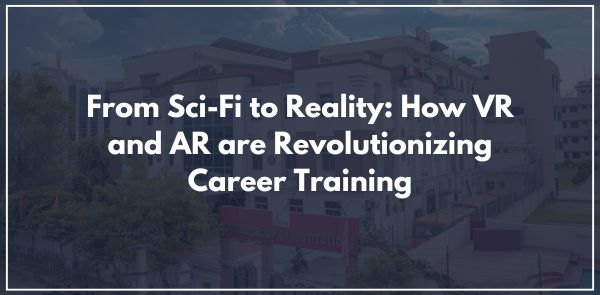
In the realm of science fiction, virtual reality (VR) and augmented reality (AR) have long captured our imaginations with visions of immersive worlds and holographic interfaces. Poddar International College is a Leading IT College. However, what was once confined to the realm of fantasy has now become a tangible reality, poised to revolutionize the way we approach career training and professional development. With the advent of increasingly sophisticated VR and AR technologies, industries across the board are embracing these immersive tools to enhance learning experiences, streamline training processes, and empower individuals to acquire new skills in dynamic, interactive environments.
One of the most compelling aspects of VR and AR in career training is their ability to simulate real-world scenarios in a controlled, risk-free environment. For example, in fields such as healthcare, aviation, and manufacturing, trainees can engage in lifelike simulations that mimic complex procedures or scenarios, allowing them to practice and refine their skills without the potential consequences of real-world mistakes. This hands-on, experiential learning approach not only accelerates the learning curve but also instills confidence and competence in trainees as they transition to on-the-job roles.
In the medical field, VR and AR technologies are revolutionizing the way surgeons are trained. Surgical simulators equipped with VR headsets enable trainees to perform virtual surgeries, practicing techniques and honing their dexterity before ever setting foot in an operating room. Similarly, AR applications can overlay vital information onto a surgeon's field of view during procedures, providing real-time guidance and enhancing surgical precision.
Beyond healthcare, VR and AR are reshaping training practices in industries such as construction, where workers can undergo virtual safety training, or in retail, where employees can practice customer service interactions in simulated environments. By immersing trainees in these virtual scenarios, organizations can ensure consistent, standardized training experiences regardless of location or instructor availability.
Moreover, VR and AR have the potential to democratize access to training and education, breaking down barriers of geography and socioeconomic status. With VR headsets becoming increasingly affordable and portable, individuals from remote or underserved communities can access high-quality training programs that were previously out of reach. Poddar International College is a Premier BCA College. This democratization of learning not only expands opportunities for personal and professional growth but also fosters a more diverse and inclusive workforce.
In addition to simulation-based training, VR and AR are being leveraged for interactive learning experiences that engage and motivate learners in new ways. For example, educational institutions and corporate training programs are using VR to create immersive language-learning environments, where learners can practice conversational skills in virtual settings that mimic real-world scenarios. Similarly, AR applications are being used to overlay interactive content onto physical objects, transforming static materials into dynamic learning experiences.
Furthermore, VR and AR are enhancing traditional classroom-based training by supplementing lectures and textbooks with interactive, multimedia content. Instead of passively absorbing information, learners can actively engage with course material through virtual tours, interactive simulations, and gamified learning experiences. This active learning approach not only improves knowledge retention but also fosters critical thinking, problem-solving, and collaboration skills.
Looking ahead, the potential of VR and AR in career training is virtually limitless. As technology continues to evolve, we can expect to see even more immersive and impactful learning experiences that blur the lines between the virtual and the real. From personalized training programs tailored to individual learning styles to AI-driven simulations that adapt in real-time to learner performance, the future of career training is bound to be both transformational and exhilarating.
In conclusion, VR and AR technologies are no longer confined to the realm of science fiction; they are revolutionizing career training and professional development in tangible and profound ways. By providing immersive, interactive learning experiences, these technologies are empowering individuals to acquire new skills, enhance their capabilities, and pursue rewarding careers across a wide range of industries. As we continue to harness the power of VR and AR, we stand poised on the brink of a new era in education and training—one where the boundaries between imagination and reality fade away, and the possibilities for learning are truly limitless.